
Vaishnavi Patil at Ellora Cave 21 with the Saptamatrika Panel.
Vaishnavi Patil, one of the Mittal Institute’s new Graduate Student Associates, is a doctoral candidate in Harvard’s History of Art and Architecture department working on South and Southeast Asia. Vaishnavi received her B.A. in Ancient Indian History and Culture from St. Xavier’s College, Mumbai, and an MA in History of Art and Archaeology from SOAS, London. She was a Yenching scholar at Peking University, China, receiving an MA in China Studies. In addition to her studies, Vaishnavi has participated in numerous internships, including curatorial training at the Metropolitan Museum of Art and the Harvard Art Museums.
Vaishnavi is interested in studying female deities, especially mother goddesses, and how production, patronage, and development of religions play a role in the evolution of the mother goddess in South Asia. She is also interested in the text-to-image relationships in South Asian art, particularly the literal and the symbolic in the illustration of a text. Other areas of interest include popular practices, marginalized deities, depiction of evil, and gender issues. Her current research aims to analyze the origins and development of the cult of the mother goddess in South and Southeast Asia, particularly her representations and the popular practices centered on her.
Mittal Institute: Welcome, Vaishnavi! Can you tell us about the motivations behind your research – why do you focus on South Asia and East Asia, and what led you to focus on the relationship between religion and art?
Vaishnavi Patil: I was interested in learning more about the past from a young age. During college, I studied history, focusing on South Asia. In my sophomore year, I was invited to participate in a site seminar with the eminent art historian, late Professor Walter Spink, at the Ajanta Caves in India in 2013, which shaped my understanding of art and aesthetics. The experience of viewing the art of Ajanta in person allowed me to go back in time to experience the site, unlike the experience of looking at slides and photographs. This visit helped me confirm my interest in studying art history. I firmly believe that experiencing art and looking at the actual object has always been a way for me to understand my world better.

Site Seminar at Ajanta Caves, Maharashtra with Late Professor Walter Spink, University of Michigan. This visit to Ajanta is most memorable because it led to Vaishnavi pursuing a career in art history.
My introduction to East Asian art was during my time at SOAS in London, when I became interested in studying art beyond South Asia. I started taking classes in Chinese painting and ceramics and eventually pursued a master’s in China studies with a particular focus on history and archaeology from Peking University. During my time in China, I could immerse myself in an unfamiliar culture, one which I could unfold and learn about through the experiences I gained in class, through my interactions with fellow students, and traveling around the country.
During my time at Harvard, I want to be able to harness all the skills I have accumulated during my studies until then and be able to keep pursuing things that have caught my interest. At the heart of my specific research interests lies a more general interest in the transmission and exchange of art within different cultures and traditions, which I hope to continue to engage with during and after my doctoral studies.
Mittal Institute: You study female deities – especially mother goddesses – in South Asia. Can you talk about this focus and your surrounding research?
Vaishnavi Patil: My dissertation in progress is titled “Tracing the Divine Mother: Representations of the Mother Goddess in South Asia” and focuses on representations of the Mother Goddess in South and Southeast Asia from the first to the tenth centuries. In illuminating the mother-child imagery, in particular, my project argues not only for the importance of such images in the development of religions of South Asia but also seeks to show the reciprocity in artistic and religious practices of the mother goddess in the various religions of the region. Through the Longue durée study of goddesses like the Buddhist Hārītī, Brahmanical Sapta-mātṝkā or Ashta-mātṝkā (Seven or Eight Mothers), and the Jain Ambikā, my dissertation aims to create an understanding of how and why the mother goddess cult developed in South Asia and what led to its assimilation in the great traditions of the region.
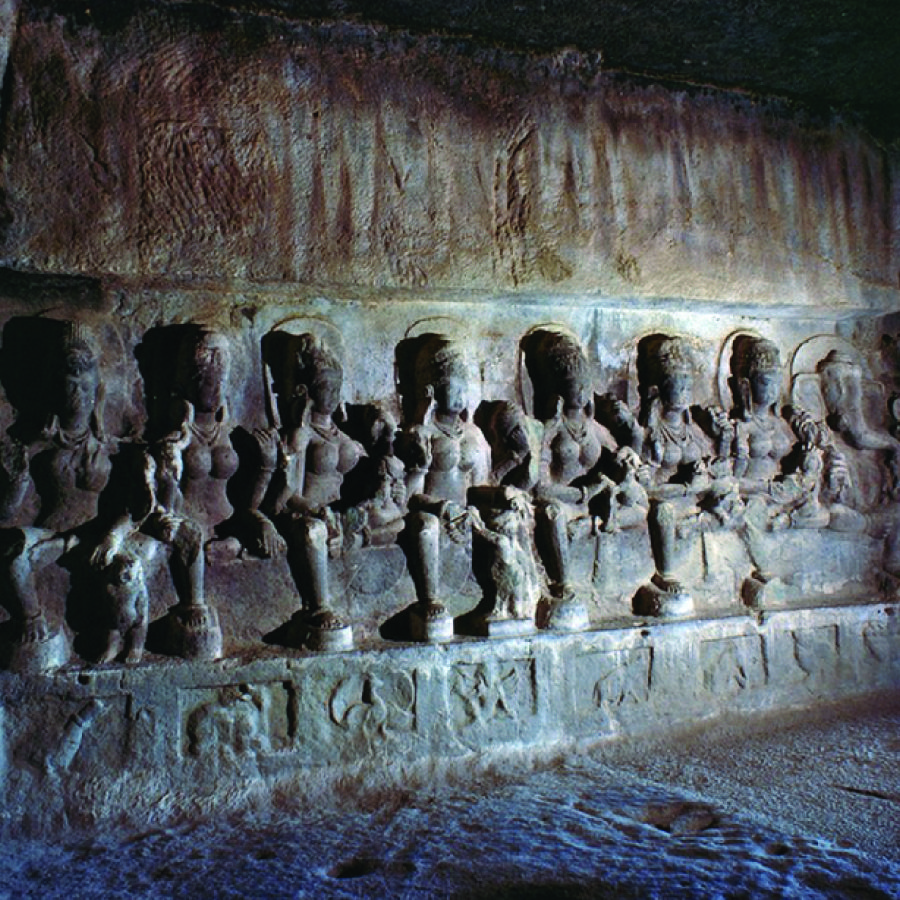
Saptamatrikas, 7th – 10th century CE. Brahmanical caves, Cave 21, Ellora, Aurangabad.
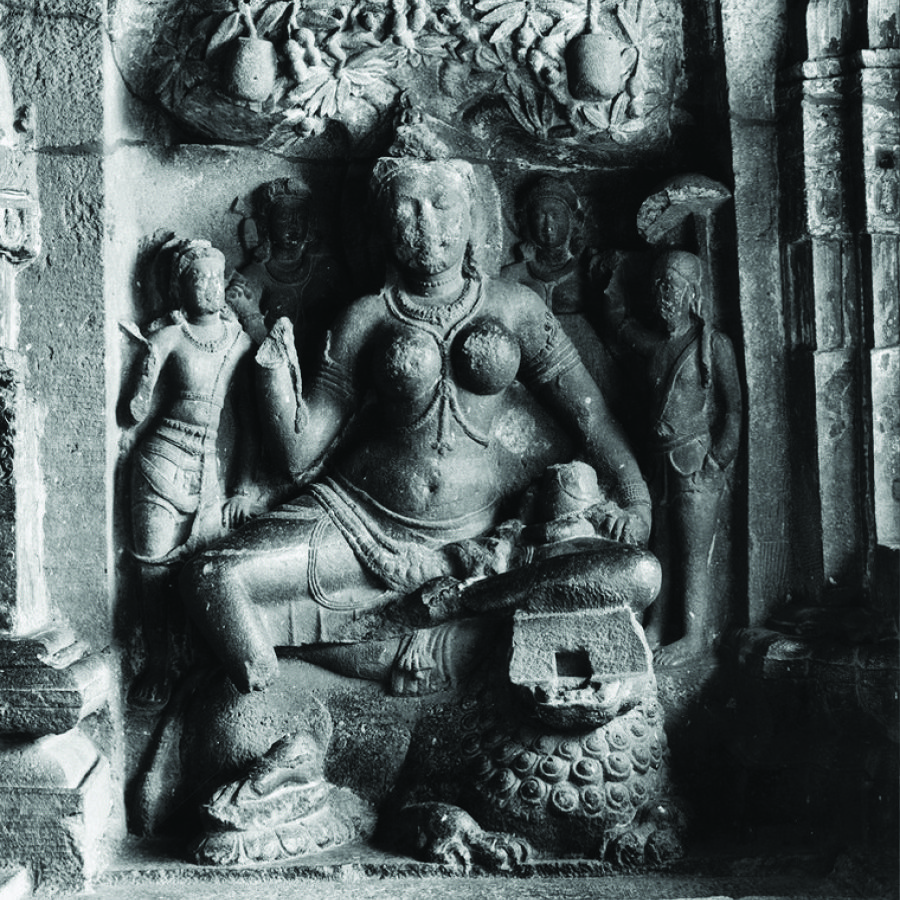
Goddess Ambika, 9th – 12th century CE. Jain caves, Cave 32, Ellora, Aurangabad.

Hariti and Panchika Shrine, 5th – 8th century CE. Buddhist caves, Cave 8, Ellora, Aurangabad.
My dissertation lies at the intersection of art history, religious studies, and gender studies. Studying these early goddesses is essential, as they are precedents to goddesses that emerged later. In doing so, I hope to contribute to the social history of early India and our understanding of the role of goddesses in the religious traditions of early South Asia. At its heart, my dissertation is a feminist history of South Asian religions and art, one in which I upend the established narrative of the androcentric religious model to explore a gynocentric understanding of religious practices.
Mittal Institute: Are there any special research projects that you are working on that you can share with us?
Vaishnavi Patil: Beyond my dissertation research, I have been involved in various projects on campus and beyond. During the past few summers, I worked with curator John Guy at the Metropolitan Museum of Art on the exhibition ‘Tree and Serpent: Early Buddhist Art of India, 200 BCE – 400 CE,’ scheduled for July 2023. I contributed to research for the exhibition and also got a chance to learn closely about the various stages of planning an exhibition at an institution such as the Met.
In Spring 2022, I also worked at the Harvard Art Museums with Curator Sarah Laursen on curating a gallery of Southeast Asian Art.
These experiences have helped me learn how innovative curatorial practices could allow audiences to connect with material culture and engage with art as evidence of history through presenting a factual narrative grounded in academic scholarship.
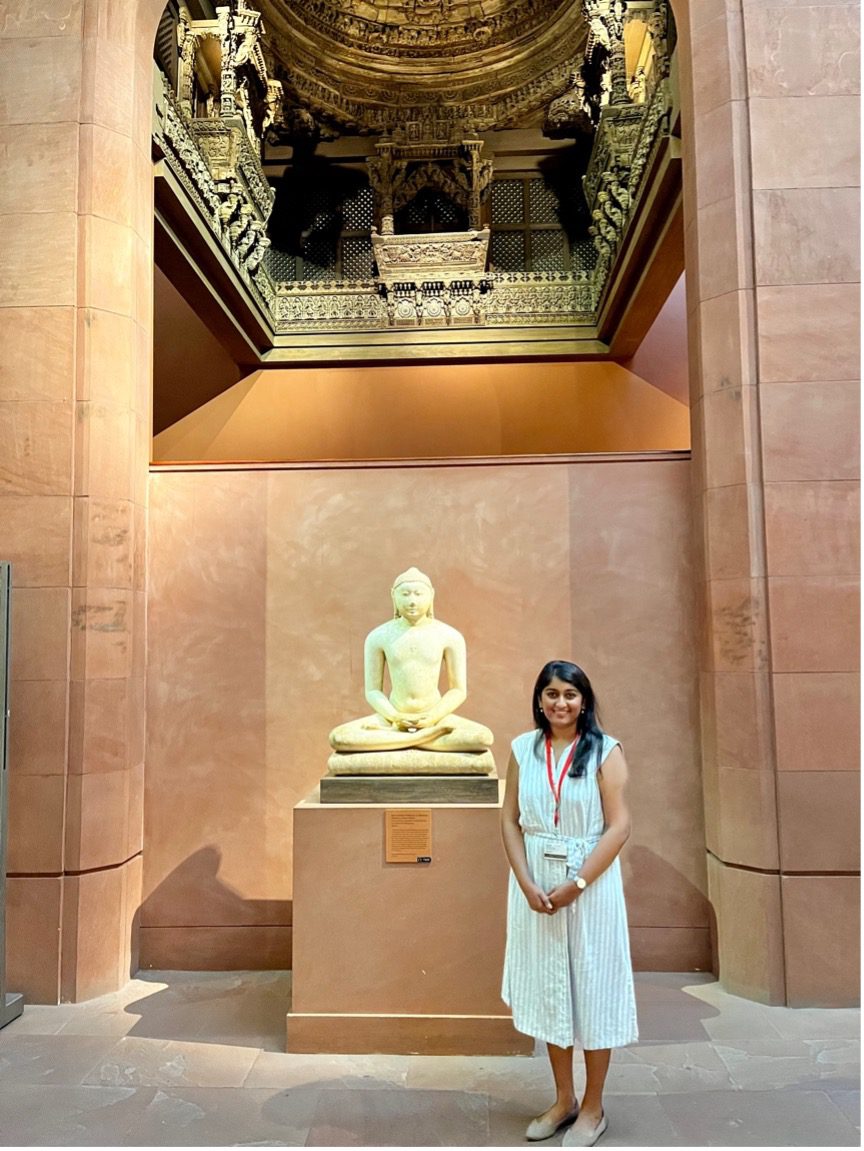
At the South Asia Art Galleries at the Metropolitan Museum of Art, New York. August 2022.
I am particularly interested in exploring the intersection of humanities and technology. I am a research assistant for the Mapping Color in History, a Project led by my advisor, Professor Jinah Kim, and supported by the Mittal Institute.
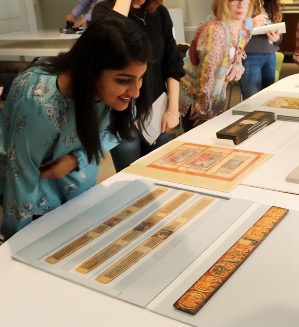
Viewing palm-leaf manuscript folios at the Virginia Museum of Fine Art, Richmond. May 2019.
One of the project’s goals is to offer a deeper understanding of the genre of painting in South Asian art— by using digital tools. I worked on reuniting a dispersed Manuscript called the “Dispersed Bhagavata Purana” — dated to the early 16th century. Folios of this manuscript exist all over the world. I created an online database for these folios and worked towards arranging them in the narrative sequence, further adding to the understanding of the manuscript.
Along the lines of interdisciplinary research, I founded the digital humanities project “A Timeline of South Asian History: Dynasties, Rulers and Key Events,” an initiative that aims to present a detailed chronology of South Asian history, stretching from the dawn of the Indus Valley civilization through 1947 CE. This project brings together new and emerging scholarship to provide the latest proposed dates providing a comprehensive chronology. The project aims to be a valuable academic resource for scholars of history, art history, South Asian studies, and those interested in the particulars of South Asia’s geographic regions.
Mittal Institute: How do you hope your alignment with the Mittal Institute will impact your research?
Vaishnavi Patil: The Mittal Institute has always been a home for South Asianists at Harvard. During my graduate studies at Harvard since 2018, I have collaborated with the Mittal Institute in numerous ways. I received grants to conduct research through visits to temples and museums in Gujarat, India. I have collaborated on various projects, contributed to conferences and panels, and been an enthusiastic attendant of many of the events Mittal Institute has organized over the years.
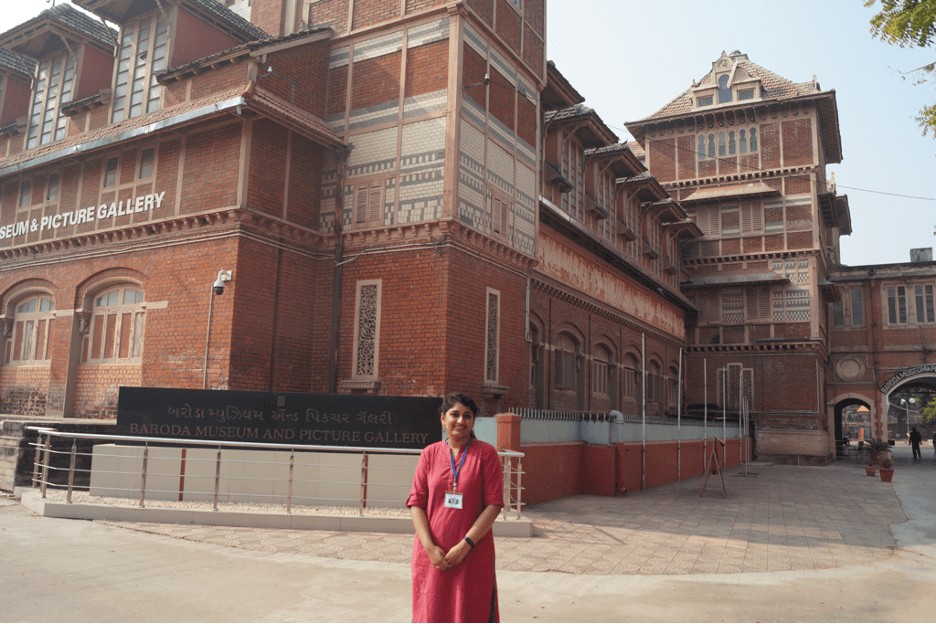
Conducting research at the Baroda Museum and Picture Gallery, Baroda, Gujarat, India. January 2020.
For the upcoming year, I will spend time in India conducting on-site research and in Cambridge consolidating my findings and working on my dissertation under the aegis of the Porter Research Travel Fellowship. As a Graduate Student Associate at the Mittal Institute, I hope to get a chance to interact with scholars who work in South Asia beyond Art History and find a community during my research year. These connections will also allow me to expand my interests and learn from the challenges that peers have faced while conducting research. Working with a group could also help me find solutions to common research and writing problems through discussions and brainstorming with the peer group.
Of the many projects that LMSAI runs, The CoSTAR Program is of particular interest to me; so is the artist residency program where LMSAI invites artists to the Cambridge campus.
Mittal Institute: What are your long-term career goals, and what is next on the horizon for you?
Vaishnavi Patil: In all the projects I have pursued, an important goal has been to bring academic scholarship to a larger audience and democratize access to Art Historical research. In the future, I plan to continue exploring the lesser known to make it visible and contribute to steering our discourse to a fact-based understanding of history.

Panelist on the “Next Generation of Scholars” Panel, The Mittal Institute’s Annual Symposium: The Making of Modern South Asia, May 18-19, 2022. Watch the panel.
I intend to complete my field research in the current academic year and then continue writing my dissertation the year after.
